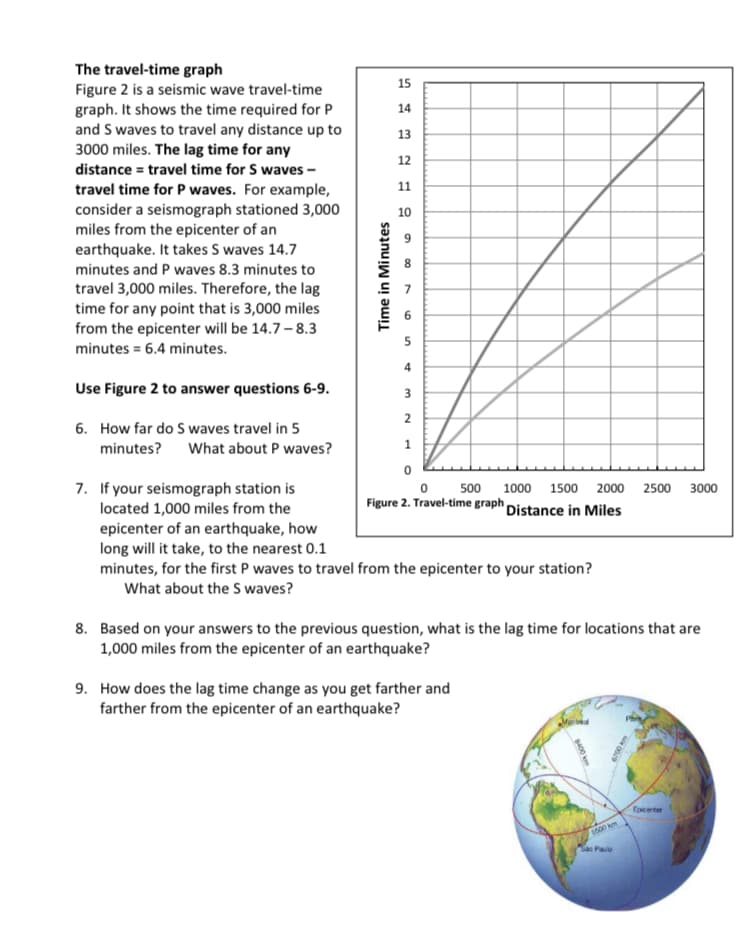Horizons: Exploring the Universe (MindTap Course List)
14th Edition
ISBN:9781305960961
Author:Michael A. Seeds, Dana Backman
Publisher:Michael A. Seeds, Dana Backman
Chapter17: Mercury, Venus, And Mars
Section: Chapter Questions
Problem 1P: Imagine that a spacecraft has landed on Mercury and is transmitting radio signals to Earth at a...
Related questions
Question
Using Figure 2 graph, how far do S waves travel in 5 minutes? What about P waves?

Transcribed Image Text:The travel-time graph
Figure 2 is a seismic wave travel-time
graph. It shows the time required for P
and S waves to travel any distance up to
3000 miles. The lag time for any
15
14
13
12
distance = travel time for S waves -
11
travel time for P waves. For example,
consider a seismograph stationed 3,000
miles from the epicenter of an
earthquake. It takes S waves 14.7
10
8
minutes and P waves 8.3 minutes to
travel 3,000 miles. Therefore, the lag
time for any point that is 3,000 miles
from the epicenter will be 14.7 – 8.3
minutes = 6.4 minutes.
4
Use Figure 2 to answer questions 6-9.
3
2
6. How far do S waves travel in 5
minutes? What about P waves?
7. If your seismograph station is
located 1,000 miles from the
epicenter of an earthquake, how
long will it take, to the nearest 0.1
minutes, for the first P waves to travel from the epicenter to your station?
50
1000 1500 2000
2500
3000
Figure 2. Travel-time graph Distance in Miles
What about the S waves?
8. Based on your answers to the previous question, what is the lag time for locations that are
1,000 miles from the epicenter of an earthquake?
9. How does the lag time change as you get farther and
farther from the epicenter of an earthquake?
Manteal
Eoicenter
S600 km
Sdc Paulo
Time in Minutes
400 km
Expert Solution
This question has been solved!
Explore an expertly crafted, step-by-step solution for a thorough understanding of key concepts.
This is a popular solution!
Trending now
This is a popular solution!
Step by step
Solved in 2 steps

Knowledge Booster
Learn more about
Need a deep-dive on the concept behind this application? Look no further. Learn more about this topic, physics and related others by exploring similar questions and additional content below.Recommended textbooks for you

Horizons: Exploring the Universe (MindTap Course …
Physics
ISBN:
9781305960961
Author:
Michael A. Seeds, Dana Backman
Publisher:
Cengage Learning

University Physics Volume 1
Physics
ISBN:
9781938168277
Author:
William Moebs, Samuel J. Ling, Jeff Sanny
Publisher:
OpenStax - Rice University


Horizons: Exploring the Universe (MindTap Course …
Physics
ISBN:
9781305960961
Author:
Michael A. Seeds, Dana Backman
Publisher:
Cengage Learning

University Physics Volume 1
Physics
ISBN:
9781938168277
Author:
William Moebs, Samuel J. Ling, Jeff Sanny
Publisher:
OpenStax - Rice University


Stars and Galaxies (MindTap Course List)
Physics
ISBN:
9781337399944
Author:
Michael A. Seeds
Publisher:
Cengage Learning

Foundations of Astronomy (MindTap Course List)
Physics
ISBN:
9781337399920
Author:
Michael A. Seeds, Dana Backman
Publisher:
Cengage Learning

Physics for Scientists and Engineers: Foundations…
Physics
ISBN:
9781133939146
Author:
Katz, Debora M.
Publisher:
Cengage Learning